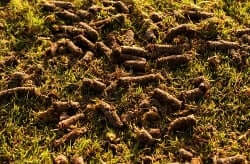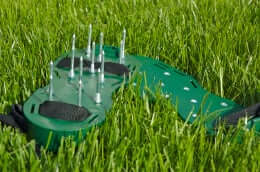How to Aerate Your Zoysia Lawn

Zoysiagrass is a warm-season grass type that originated from Asia. It tolerates a variety of soils, can be grown in partial shade, is very traffic tolerant, and can handle overly saline soils. It does, however, have two seemingly contradictory disadvantages: it tends to grow thick thatch layers, and it is an extremely slow-growing grass.
Thatch is the layer of dead stems, roots, and rhizomes that exists between the green, growing grass and the soil. Thatch accumulates because many of these plant materials contain ligin, which is slow to decompose. Because the microorganisms cannot break down the thatch material quickly enough, a layer grows. Anything thicker than ½” can cause the zoysia grass lawn problems. Water, oxygen, and nutrients have a difficult time penetrating the thatch layer, and diseases and pests can find a safe haven in the thatch layer. The thatch layer also can cause a lawn mower to sink and scalp the lawn. Usually dethatching with a special rake or a vertical mower helps to get rid of a thatch layer. But it is very stressful to the lawn and usually requires some reseeding with zoysia grass seed afterward. Because it takes so long for this species to grow over injuries, de-thatching is not the best route.
A better option is aeration, which is usually done to correct compacted soils but also helps to lessen a thatch layer. Aeration involves pulling plugs from the soil and leaving them on the lawn to break down. Not only do the new holes help loosen the soil and increase oxygen levels, but the soil plugs also help increase the microbial activity and break down the thatch layer more quickly.

To aerate, you will need to rent a core aerator from a garden supply store. Don’t be fooled by the spiked shoes marketed to be aerators—if the device doesn’t remove soil from the ground, then it certainly isn’t going to aerate the soil and will probably only increase the soil’s compaction.
Make sure that you are aerating while the lawn is actively growing (during the late spring and through the summer), and that you aerate on a day that isn’t too hot. Mow shorter than usual a couple of days before you aerate, and give the lawn a light irrigation.
As you use the core aerator across the lawn, you should be removing soil plugs that are 2 to 3” deep and ¾” in diameter, and you should be removing 20 to 40 plugs of soil per square foot. Run the core aerator back and forth across the lawn in one direction, and then repeat in a direction at a 90º angle to the first direction. That way you won’t miss any areas. And remember to overseed with zoysia grass seeds to encourage new growth and recovery.
While the soil plugs may look unsightly to you, don’t remove them! They are what will help break down your thatch layer. If it makes a difference, you can lightly rake across your lawn to break up the soil plugs for a more even look.
A yearly aeration can help your zoysiagrass lawn battle its tendency to create thick thatch layers and thereby improve its overall growth.
View More Guides
Get instant access to all of our premium pasture seed products by entering your zip code into our exclusive Seed Selector!